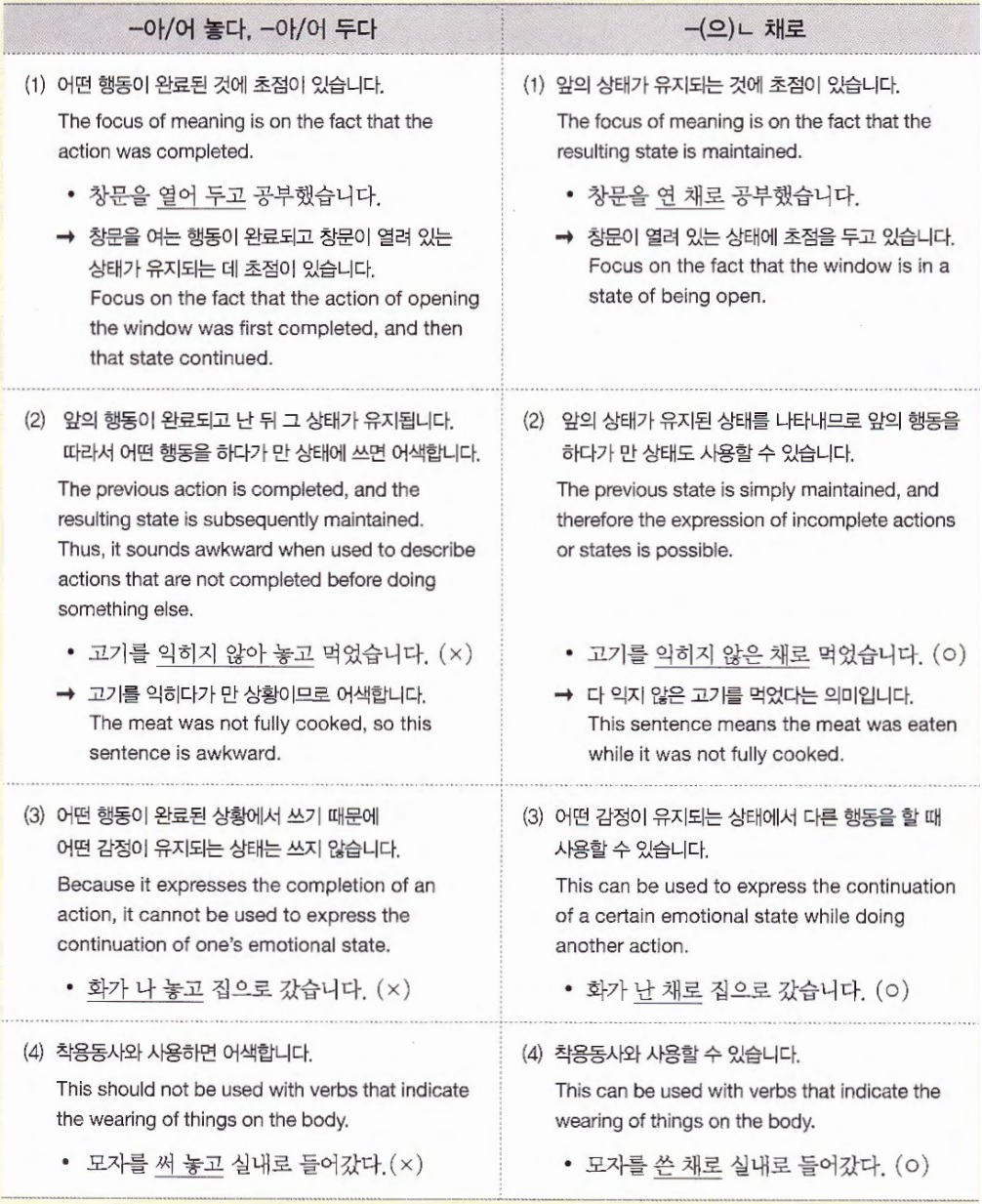 가: 무슨 안 좋은 일 있어요?
가: 무슨 안 좋은 일 있어요?
Did something bad happen?
나: 아키라 씨가 밤마다 술이 취한 채로 저에게 전화를 걸어서 짜증이 나요.
I’m frustrated because Akira calls me every night drunk.
가: 아키라 씨가 자야 씨를 좋아하나 봐요,
It looks like Akira likes you, Jaya.
가: 옷이 왜 이렇게 젖었어요?
Why are your clothes so wet?
나: 수영복을 안 가지고 와서 옷을 입은 채로 수영을 해서 그래요.
I didn’t bring my swimsuit, so I went swimming with my clothes on.
This expression is used to indicate that the action in the following clause is performed while in the state, or under the circumstances, described in the preceding clause. The present and future tenses are not used before -(으)ㄴ 채로. This expression can also be shortened to -(으)ㄴ 채 by omitting the particle 로.
 • 목이 너무 말라서 냉장고 문을 열어 놓은 채로 물 한 병을 다 마셨습니다.
• 목이 너무 말라서 냉장고 문을 열어 놓은 채로 물 한 병을 다 마셨습니다.
I was so thirsty that I drank an entire bottle of water with the refrigerator door open.
• 저는 안경을 쓴 채로 안경을 찾는 경우가 가끔 있어요.
I sometimes start looking around for my glasses while I have them on.
• 은영 씨는 부끄러운 듯 계속 고개를 숙인 채 이야기를 했어요.
Eunyeong, seeming embarrassed, kept talking with her head down.
1. The verbs 가다 and 오다 are not used before -(으)ㄴ 채로.
• 학교에 간 채로 공부했어요. (X)
->학교에 가서 공부했어요. (〇)
2. This expression is not used to describe situations that are naturally expected after the preceding action occurs.
• 가스 불을 켠 채 라면을 끓였어요. (X)
->가스 불을 켜고 라면을 끓였어요. (〇)
Because it is obvious that heat is required to cook noodles, here the use of -(으)ㄴ 채로 sounds awkward.
3. This expression is also often used in the forms -아/어 놓은 채로 and -아/어 둔 채로.
• 문을 닫은 채로 요리를 해서 집안에 냄새가 심하게 나요.
= 문을 닫아 놓은 채로 요리를 해서 집안에 냄새가 심하게 나요.
= 문을 닫아 둔 채로 요리를 해서 집안에 냄새가 심하게 나요.
The house reeked of cooking because I cooked with the door closed.
While -아/어 놓다, -아/어 두다, and -(으)채로 all refer to the continuation of a state or action, they have the following differences.

>> You can click on the title of each grammar below to learn about the other grammar which also expresses ‘Situational States of Being’:
01 -아/어 놓다
02 -아/어 두다
03 -(으)ㄴ 채로
04 -(으)ㄴ/는 대로
>> Full of Intermediate grammar: Click here
